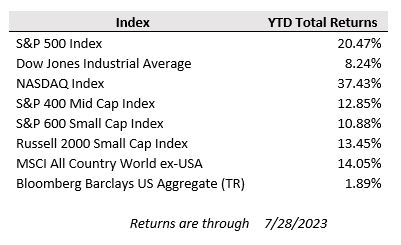U.S. equities logged another week of gains amid one of the busiest weeks of the year, headlined by several key central bank meetings, the peak of second quarter corporate earnings season, and the release of important economic data points including GDP and inflation. For the week, the S&P 500 climbed 1.0% while the Dow Jones and Nasdaq Composite rose 0.6% and 2.0%, respectively. The S&P 500 now sits within 5% of the index’s all-time high set at the start of 2022 following its 20% year-to-date surge.
The Federal Reserve last Wednesday delivered a widely expected 0.25% rate hike, bringing the fed funds rate to its highest level in 22 years with a target of between 5.25% and 5.50%. Market participants believe this was the final rate hike in what has been the central bank's most aggressive tightening campaign in decades, with recent data on inflation pointing towards a potential pause in the raising of interest rates.
Fed Chairman Powell in his post-decision press conference said that the Fed staff was no longer forecasting a decision for future meetings (the next of which is set for September 19th and 20th). Additionally, he firmly reiterated the central bank's 2% inflation target and stressed that there would be no rate cuts this year. While the outlook for further rate hikes will depend on economic & inflation data over the coming months, Powell and his committee members have indicated that they would rather err on the side of tightening too much to avoid the risk of leaving conditions too loose, thereby allowing inflation to reignite.
U.S. economic data has shown little evidence of cracking under the rising monetary policy pressure, and activity has even accelerated in some areas of the economy. On Thursday, the Bureau of Economic Analysis said U.S. GDP grew at an annualized rate of 2.4% in Q2, almost an entire percentage point stronger than the expected figure of +1.5% and higher than the +2% growth in Q1. The report showed an acceleration in private inventory investment and nonresidential fixed investment, while consumption cooled from first quarter but remained quite strong, especially in the service sector. The resilience of the U.S. consumer was further confirmed by other data points last week including rising consumer sentiment and falling weekly jobless claims.
Friday’s release of the June personal consumption expenditure price index, the Fed’s favored inflation gauge, further stoked investor enthusiasm as it showed inflation moderating more than expected. Annualized PCE growth marked the lowest level in nearly two years as it decelerated to 3.0% year-over-year from 3.8% in May. Both sets of data have bolstered bets among market participants of a goldilocks “soft landing” scenario in which economic growth will remain resilient while inflation will continue to cool.
Last week also saw the start of the busiest part of the second quarter earnings season, with scores of heavyweight companies announcing their results. Tech leaders Microsoft and Alphabet led the way. Microsoft stock slid on concerns over its planned spending on artificial intelligence. Conversely, Alphabet surged to a 15-month high after the Google-parent's quarterly report showed modest but steady growth on the back of advertising revenues of nearly $60B.
The week ahead will include another important stretch of corporate earnings, as the latest results from tech titans and consumer products giants give further insights into the U.S. economy — as will the latest jobs report. The Bureau of Labor Statistics will publish nonfarm payroll data for July on Friday. Economists expect the U.S. to have added about 200,000 jobs, with unemployment staying level at about 3.6 percent. The report is sure to weigh on the Fed’s deliberations about borrowing costs, ahead of their September meeting.



